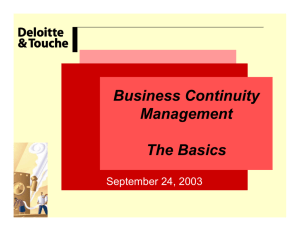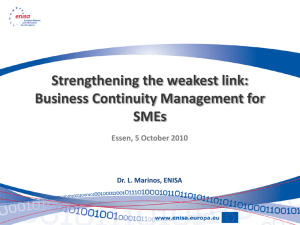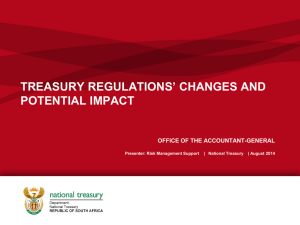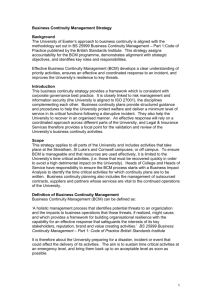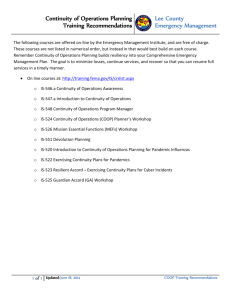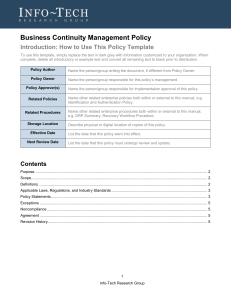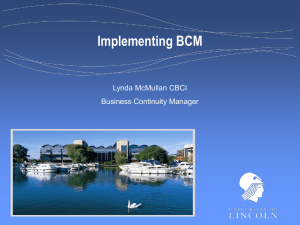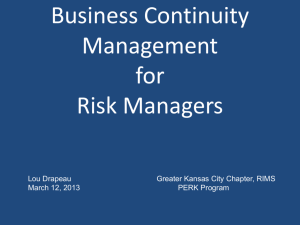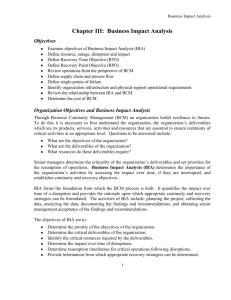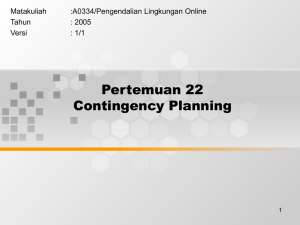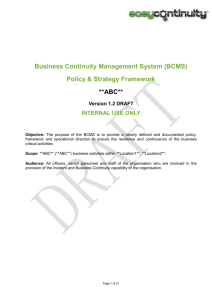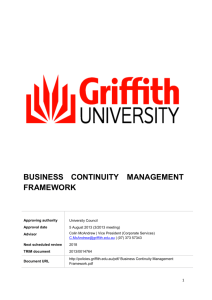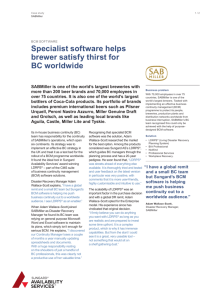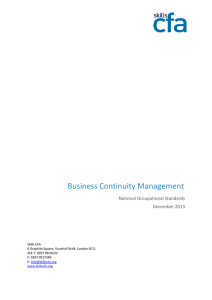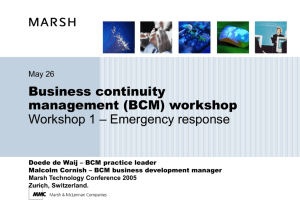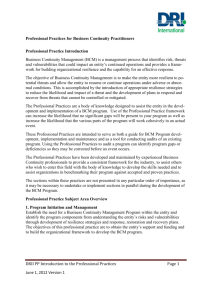(Attachment: 5)BUSINESS CONTINUITY PLANNING
advertisement
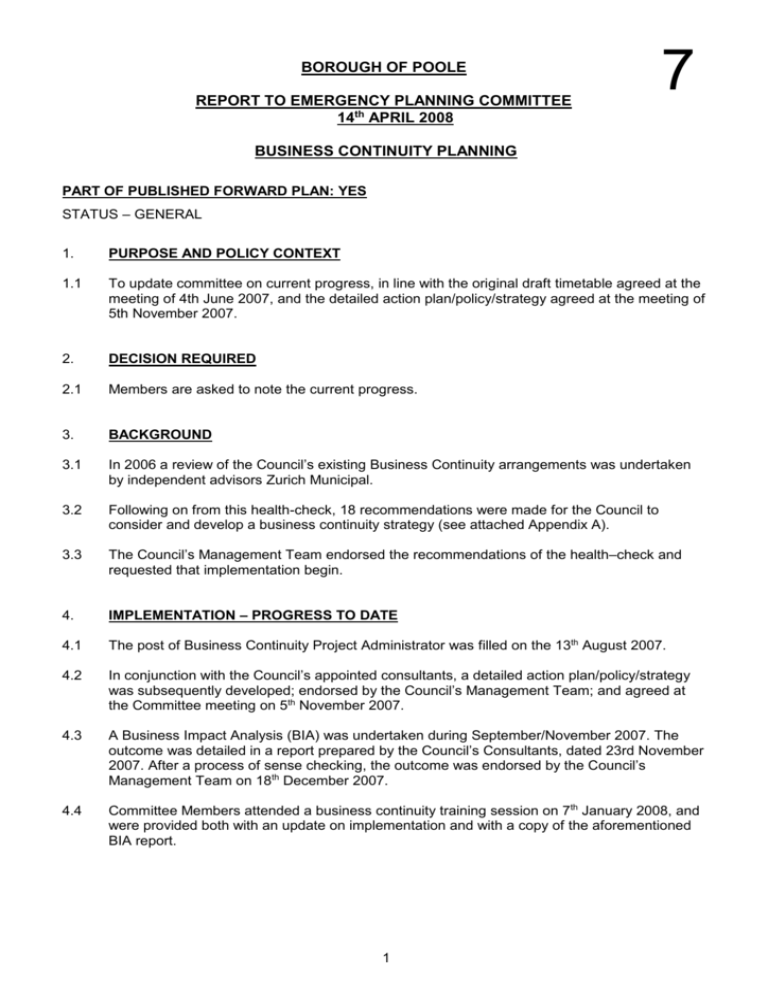
BOROUGH OF POOLE REPORT TO EMERGENCY PLANNING COMMITTEE 14th APRIL 2008 7 BUSINESS CONTINUITY PLANNING PART OF PUBLISHED FORWARD PLAN: YES STATUS – GENERAL 1. PURPOSE AND POLICY CONTEXT 1.1 To update committee on current progress, in line with the original draft timetable agreed at the meeting of 4th June 2007, and the detailed action plan/policy/strategy agreed at the meeting of 5th November 2007. 2. DECISION REQUIRED 2.1 Members are asked to note the current progress. 3. BACKGROUND 3.1 In 2006 a review of the Council’s existing Business Continuity arrangements was undertaken by independent advisors Zurich Municipal. 3.2 Following on from this health-check, 18 recommendations were made for the Council to consider and develop a business continuity strategy (see attached Appendix A). 3.3 The Council’s Management Team endorsed the recommendations of the health–check and requested that implementation begin. 4. IMPLEMENTATION – PROGRESS TO DATE 4.1 The post of Business Continuity Project Administrator was filled on the 13th August 2007. 4.2 In conjunction with the Council’s appointed consultants, a detailed action plan/policy/strategy was subsequently developed; endorsed by the Council’s Management Team; and agreed at the Committee meeting on 5th November 2007. 4.3 A Business Impact Analysis (BIA) was undertaken during September/November 2007. The outcome was detailed in a report prepared by the Council’s Consultants, dated 23rd November 2007. After a process of sense checking, the outcome was endorsed by the Council’s Management Team on 18th December 2007. 4.4 Committee Members attended a business continuity training session on 7th January 2008, and were provided both with an update on implementation and with a copy of the aforementioned BIA report. 1 5 IMPLEMENTATION TIMETABLE 5.1 Implementation continues to track the agreed business continuity strategy. Headline activity for the coming quarter is set out under 5.2, 5.3, and 5.4 below. 5.2 Corporate planning workshop, 13th March. Recovery strategies were reviewed for each of the key corporate mission critical services, as identified within the aforementioned BIA report. The adequacy or otherwise of current risk mitigation resources will be assessed, and draft business continuity plans prepared, for each of these mission critical services. Draft plans are due to be completed by June, and will then be submitted to Management Team and Committee for approval. 5.3 Service Unit planning workshop, scheduled for 15th April. Not all Service Units have key corporate mission critical services. Nevertheless, we wish to disseminate best practice, and ensure that all Service Units have an opportunity to develop business continuity plans at Service Unit level. Appropriate training will be provided through this workshop, and subsequent support will be available from the Business Continuity Project Administrator. 5.4 Corporate Incident Management workshop, to be held in June/July (firm date to be finalised). 6 RECOMMENDATIONS 6.1 That this report is accepted. 6.2 That further progress reports continue to be submitted to this committee at six monthly intervals, until completion of the project in July 2009. Ian Milner Acting Head of Financial Services Consultant Reports: Business Continuity Management Healthcheck, October 2006. BIA, 23rd November 2007. Name and Telephone Number of Officer to Contact: Paul Smith Business Continuity Project Administrator Tel: 01202 633177 SPSACmarch2006- Activity 2 7 APPENDIX A Recommendations 1. A Business Continuity Management (BCM) Policy must be agreed, documented and Priority High approved, outlining the people who are accountable for BCM and emergency planning, their responsibilities and authority. This policy must have visible senior sponsorship and support and should be accompanied by an action plan of activity to roll out a programme of work on BCM. 2. Senior management must champion and support BCM, ensuring that their buy in to High the process is understood by all. Without this support any BCM programme is unlikely to succeed. 3. The BCM programme must have a budget and resources allocated to it as part of High the normal budgeting and management processes. BCM takes significant time and commitment to implement and this must not be underestimated by the Authority. 4. An exercise must be carried out at a corporate level to identify and prioritise High the council’s critical activities. This then informs the identification of the resources required to perform those activities so that the most important can be recovered after an emergency situation. This forms the basis of the corporate level of the Business Continuity Planning (BCP). The exercise must be done against criteria such as priority of activity, duration able to continue without activity and extent of alternative provision in place. 5. The next step after the identification of the Management Consultancy High Agents (MCA) is to analyse the impact of a range of emergency situations on them. A structured process for business impact analysis that identifies risks and their potential impact on services, critical activities and dependencies must be developed and used consistently at both corporate and then service level. This must include the identification of high-risk concentration, such as several MCA in one building. 6. The Council must ensure that it has an up to date risk assessment considering the likelihood and impact of business continuity risks. Risk mitigation activity must be evidenced where possible to show that activities to reduce or prevent the risks occurring are taking place, as well as business continuity plans compiled. This risk assessment must include internal as well as external emergencies as there may be a tendency to 3 High focus on traditional external threats, such as fire, floods or terror and to miss internal disruptions such as an interruption to a key supplier or industrial action. 7. Once the MCA for the Council has been identified the corporate level High strategy must be compiled, drawing on the work already in the Incident Response Plan regarding team structures and such like. 8. Once the corporate level strategy has been set, work can be done on High reviewing and completing the process and recovery level strategies. 9. A communication strategy as to how the Council will communicate with Medium stakeholders in the event of an incident must be drawn up. 10. All agreed strategies must be signed off at the appropriate level and Medium communicated effectively to those impacted or involved in their implementation. 11. A template for the BCP must be agreed, rolled out and completed High corporately and then for all service units in which MCA have been identified initially and then other service units as deemed necessary going forward. This should be done in a phased way with consideration given as to how to keep the process manageable. The Council will not need 21 service unit plans, it must use the MCA process to identify priority areas. A generic template is being submitted along with this report however it is vital that any document used going forward fits the organisation so the adoption of an existing internal plan may be the best course of action. The one thing missing from the organisation is the corporate planning parts of the generic template, elements of which may be found in the Incident Response Plan. 12. One area that appears to be missing from existing plans is reference to a High communication strategy/plan, as previously highlighted. 13. It must be regularly checked that all key individuals with roles and High responsibilities in the Incident Response Plan fully understand those roles, know how to access the Plan and keep their contact information up to date. 14. A Plan for a “4 hours out” scenario for the Civic Centre has been proposed and, once the template has been agreed we would recommend the drawing up of this plan – co-ordinated and informed at a corporate level. The issue of priority access should be resolved by the previously recommended work of a corporate identification of MCAs. 4 Medium 15. All those with responsibility for completing BCM exercises going forward Medium must receive sufficient training and support to enable them to do this effectively, including the senior management team and members. 16. A programme of awareness raising of BCM issues and plans must be rolled Medium out to all employees once the Council’s arrangements are more robust in terms of direction. All employees may potentially be impacted by BCM so all should be aware. This programme can be through briefs at team meetings or through a more structure programme of workshops. 17. Any arrangements in plans must be fully procured and agreed before High inclusion in plans. Otherwise, the plans are sure to fail under scrutiny. 18. Once the BCM programme is agreed, rolled out and BCP(s) produced a programme of testing, maintenance and review must be established. Each plan should contain it’s own arrangements but this should be co-ordinated centrally and corporate testing also carried out. 5 Medium
